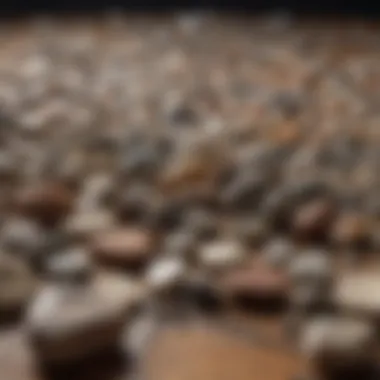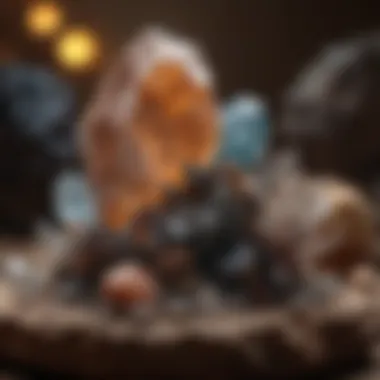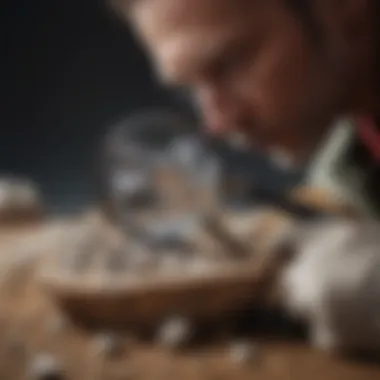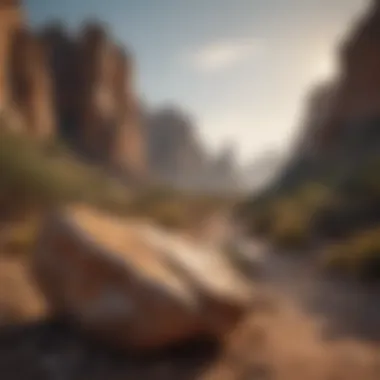Mastering the Art of Rock Collecting


Intro
Rock collecting isn't just a hobby; it's a gateway to understanding and appreciating the world we live in. From the shimmering facets of quartz crystals to the textured layers of sedimentary rocks, each specimen tells a story. This comprehensive guide aims to illuminate the nuances of rock collecting, tailored for both newcomers and veteran geologists. It will cover everything from the history and cultural significance to practical tips on identification and classification.
Many people often overlook the significance of rocks, dismissing them as mere artifacts of nature. However, their formations and characteristics are mesmerizing and complex, evolving through myriad geological processes. As we progress through this guide, collectors will not only learn how to identify various types of rocks but also understand the stories behind their formation.
History and Origins
Overview of Collectibles, Rocks, and Fossils
Rock collecting can be traced back to ancient times, when civilizations would gather stones for various purposes—from tool-making to decorative art. Early collectors were often motivated by curiosity or necessity. For instance, the ancient Egyptians prized lapis lazuli, a blue stone that symbolized royalty, while the Chinese valued jade for its beauty and supposed protective properties. Fossils, on the other hand, captured the imagination of scientists and enthusiasts alike, serving as relics from the past that illuminate the Earth’s history.
Historical Significance and Cultural Impact
Across cultures, rocks and fossils have held significant meaning. Notably, the tradition of collecting stones is evident in the historical records of many societies. The Greeks and Romans revered specific minerals, believing they possessed divine qualities. In the 18th century, the scientific revolution sparked a greater interest in geology, prompting collectors to categorize and study rocks systematically. Collecting rocks became a blend of art, science, and passion, laying the groundwork for modern geology as a discipline.
The tale of a rock’s journey from earth to collector’s shelf embodies the very essence of geological processes, time, and chance—all intertwined.
Through these historical lenses, rock collecting emerges not just as a pastime but as part of a larger narrative that connects humanity to the Earth. It invites us to explore our planet’s depths, appreciate its beauty, and celebrate its diversity. As we dive deeper into the guide, the interplay between geological time and human culture will reveal itself, demonstrating that every stone we collect is a small piece of a much grander puzzle.
Identification and Classification
The art of identifying rocks requires patience and practice. It's essential to learn the basic properties of rocks, such as color, texture, and hardness. This section provides a clear pathway for anyone looking to enthusiastically engage with their findings.
Guide to Identifying Rocks and Fossils
Identification begins with observation. Consider the following characteristics:
- Color: This immediately draws attention. However, remember that weathering can change a rock’s color.
- Texture: Underlying textures can provide clues about how the rock was formed—whether through cooling magma or accumulated sediments.
- Hardness: Utilizing the Mohs scale can help rank the hardness of minerals found in rocks.
Each rock will have defining features that tell its story and help you correctly classify it.
Common Types and Variations
The world of rocks is diverse. Here are some common types you may encounter:
- Igneous Rocks: Formed from the cooling and solidification of magma. They can be found in settings like volcanic areas. Examples include granite and basalt.
- Sedimentary Rocks: These develop from the accumulation of sediment, often found in riverbeds and old ocean floors. Sandstone and limestone are well-known types.
- Metamorphic Rocks: Created under high pressure and temperature conditions, changing the original rock. Think granite turning into gneiss or limestone becoming marble.
Understanding these classifications will enhance your rock collection experience, allowing you to appreciate the uniqueness of each specimen. With knowledge comes empowerment, and collectors can better appreciate the intricacies behind their geological treasures.
As we progress through this guide, the aim is to cultivate a deeper awareness of rock collecting, guiding seasoned and novice enthusiasts alike toward a greater understanding of Earth's natural wonders.
Prologue to Rock Collecting
Rock collecting can often feel like a journey through time, as each specimen holds stories of Earth's geological history within its layers. For many, this hobby goes beyond merely gathering rocks; it intertwines with an appreciation for nature and a curiosity about the planet we inhabit. By delving into the world of rocks, collectors typically uncover a variety of interests – from scientific inquiry to simple aesthetic appreciation. As we embark on this exploration, it's essential to understand why rock collecting captivates so many individuals.
Understanding the Appeal
The allure of rock collecting lies in its multifaceted charm. For one, there’s the thrill of discovery, akin to being a treasure hunter, but instead of chests full of gold, you’re unearthing vibrant layers of sediment and hardened magma. The different textures, colors, and formations speak to a world that predates human existence, presenting a tangible connection to evolution and the turning of ages.
Often, collectors find a specific niche that resonates with their interests. For instance, you might be drawn to vibrant minerals with sparkling surfaces or gravitate towards fossils that whisper ancient tales of life on Earth. The excitement doesn’t stop there; swapping finds with fellow enthusiasts or exploring picturesque landscapes boosts camaraderie among collectors. This sense of community can make every excursion rich and rewarding, turning simple outings into adventures.
Navigating the World of Rocks
Navigating through the vast world of rock collecting involves more than just picking up stones. It requires understanding various rock types and their origins. Essentially, rocks are classified as igneous, sedimentary, or metamorphic, each type telling its own unique story about how it came to be. Choosing the right rocks means developing a discerning eye and adjusting your collection methods as you learn.
Visual identification goes a long way. For example, smooth, glassy textures often indicate volcanic rocks, while layering typically points to sedimentary rocks. Knowledge of local geological formations can aid your hunt immensely.
Furthermore, knowing when and where to collect is paramount. Some regions are hotbeds for particular specimens but may also be governed by strict regulations. Being informed about local laws not only enhances your experience but also respects and preserves the environment.
Ultimately, rock collecting can serve as a personal journey of exploration. Whether you’re on solitary walks through your local trails or deep into the mountains, each rock in your collection is a snapshot of a moment and a piece of Earth's history. As we delve deeper into the intricacies of rock collecting, keep in mind that the ultimate goal isn't just to build an impressive collection, but to foster a lifelong appreciation for the beauty and complexity of our world.
Preparing for Your Rock Collecting Journey
Embarking on a journey to collect rocks isn't just about the thrill of discovery; it is a multifaceted endeavor that requires careful consideration and preparation. Setting the stage properly can make the difference between a lackluster experience and an exhilarating adventure filled with geological treasures. Understanding what to bring along and where to go ensures the time spent picking up rocks is enjoyable and fruitful.
Essential Supplies


When it comes to rock collecting, being well-equipped can’t be overstated. The right tools and supplies not only help in finding and collecting rocks but also ensure that your specimens are well-preserved. Here’s a list of some essential items you should consider keeping on hand:
- Rock Hammer: This is often an indispensable tool for any collector. A sturdy rock hammer allows you to crack open rocks and geodes to discover what lies within.
- Safety Goggles: Protecting your eyes is key, especially when using a rock hammer or working near rocky terrains. A sturdy pair of goggles can save you from unexpected mishaps.
- Hand Lens or Magnifying Glass: To give a closer look at the minerals or fossils in your rocks, a hand lens can be quite handy. It lets you see details that are otherwise invisible to the naked eye.
- Field Guide: A comprehensive guidebook specific to your region that covers identification can greatly enhance your knowledge when you are out in the field.
- Backpack: Don't skimp on a good, comfortable backpack. You’ll need it for carrying your supplies and any new rock finds you collect along the way.
- Notebook and Pen: Keeping track of where you found a particular rock and its characteristics will help compile your later findings. It's also great for jotting down thoughts and observations.
- First Aid Kit: Accidents can happen in the great outdoors, so having a basic first aid kit readily available is wise.
Each journey will vary in terms of requirements based on the specific location and the type of rocks you're after, but these essentials are a solid foundation.
Choosing the Right Location
The saying goes, "Location, location, location!" This adage holds just as true in rock collecting as it does in real estate. Not all places are created equal when it comes to rock harmony. Selecting the right location is vital to both the quantity and quality of your findings. Here are some factors to consider when mapping out your rock-collecting adventure:
- Research Local Geology: Understanding the geological makeup of your area will help you pinpoint places where interesting rocks could be found. Mineral-rich areas, ancient shorelines, or mountainous terrains often yield fascinating specimens.
- Respect Nature: Some places may have restrictions or guidelines that promote conservation. Before you pack up for the day, ensure you’re familiar with local regulations regarding collecting. Respecting these guidelines not only protects the environment but also helps maintain your good standing as a responsible collector.
- Ask the Experts: Don't hesitate to reach out to local geology clubs or online communities such as those found on Reddit or Facebook. Engaging with seasoned collectors can provide insights into lesser-known spots that might not be in typical guidebooks.
- Adapt to Seasonal Changes: Some locations can change dramatically with the seasons. Areas that are rich in rock during spring might be barren in the heat of summer or buried under snow in winter. Planning your trip around these seasonal aspects can be key to a successful outing.
Choosing the right location, coupled with appropriate preparations, amplifies your potential for success in the captivating world of rock collecting. The more thoughtful you are about your journey, the more enjoyable and enriching the experience will be.
Identifying Different Types of Rocks
When venturing into the world of rock collecting, knowing how to identify various types of rocks can be immensely beneficial. Not only can it enhance your collecting experience, but it also adds depth to your understanding of geological processes. Each category of rock tells a distinct story – from its formation to its unique characteristics, which can even include historical significance. By grasping the fundamentals of rock classification, you equip yourself with the tools to make informed decisions during your collections, whether you are scouring a dusty trail or sorting through your latest haul.
Igneous Rocks
Igneous rocks are born from the fiery depths of the Earth, literally. Formed through the cooling and solidification of molten rock, or magma, these stones are categorized into two main varieties: intrusive and extrusive. Intrusive igneous rocks, like granite, cooling slowly beneath the Earth’s surface, leading to larger crystals that make for beautiful specimens. Conversely, extrusive igneous rocks, such as basalt, form when lava erupts and cools quickly on the Earth’s surface, resulting in smaller crystals.
Key Characteristics of Igneous Rocks:
- Texture: Look for glassy appearances in extrusives and coarse textures in intrusives.
- Color: Typically, igneous rocks can be lighter or darker based on their mineral content. Often, lighter colors indicate higher silica content.
When collecting igneous rocks, it’s worthwhile to consider their environment. Check out areas near volcanic formations or ancient lava flows where these rocks may surface.
Sedimentary Rocks
Sedimentary rocks are like nature’s scrapbook, capturing layers of history in their strata. Formed by the accumulation of debris, mineral particles, or organic material, these rocks provide valuable information about Earth’s past climates and environments. Common examples include sandstone, limestone, and shale.
To identify sedimentary rocks:
- Layers: Noticeable layers or bands within the rock typically signify sedimentary origins.
- Fossils: Many sedimentary rocks contain fossils that can hint at the time period they were formed in.
- Composition: Often, sandy textures or gritty feels are common indicators.
In the field, look for riverbeds, lake shores, or areas with sediment deposits. They present perfect opportunities to stumble upon these historical treasures.
Metamorphic Rocks
Metamorphic rocks are simply igneous or sedimentary rocks that have undergone transformation due to intense heat, pressure, or chemically active fluids. This metamorphism solidifies, changes their structure, and often gives rise to stunning visual patterns. Examples include schist, marble, and gneiss.
Recognizing Metamorphic Rocks:
- Foliation: Many metamorphic rocks exhibit a banded or layered appearance, known as foliation, which results from the pressing forces they endure.
- Hardness: Often, they are more durable compared to their original forms, making them easy to spot once you’re familiar with the feel.
When on the hunt for metamorphic specimens, pay special attention to regions facing significant geological activity, such as mountain ranges, where layers of rock are likely to have been subjected to metamorphic processes.
"The earth has music for those who listen" - Shakespeare. Understanding the types of rocks can make your collecting journey more melodic and meaningful.
Techniques for Collecting Rocks
Collecting rocks isn’t just about picking up pretty stones; it’s an art form that involves various techniques to ensure both the enjoyment and integrity of your collection. Considering the right methods can profoundly affect the quality of the specimens you gather, ultimately shaping your experience as a collector.
Manual Collection Methods
Manual methods are the bread and butter of rock collecting, often favored for their simplicity and direct connection to nature. Without needing heavy equipment, collectors can explore various landscapes, using their hands and perhaps a basic toolkit to navigate their quarry. This technique has multiple benefits:
- Natural and Intuitive: The act of sifting through dirt and peering under rocks promotes a deeper understanding of geology and enhances observational skills.
- Physical Engagement: Climbing hills, wading through streams, or trekking through forests adds an element of fitness and adventure, making collection an enriching physical activity.
- Discovery of Variety: Scouring the ground allows collectors to discover a great deal of diversity in smaller spaces, often leading to unexpected finds like fossils or unique mineral formations.
When using manual methods, it’s essential to pay attention to local laws and guidelines. For example, certain sites may restrict digging or collecting to preserve the environment. Thus, it’s advisable to contact local geological surveys or park services beforehand. This approach not only reflects respect for nature but also ensures sustainable collecting practices.
Using Tools for Extraction
While manual methods have their charm, the incorporation of tools can elevate the rock collecting experience, allowing you to extract specimens more efficiently and safely. Having the right tools in your arsenal ensures you can tackle different types of surfaces effectively. Here are some common tools and their uses:
- Rock Hammer: This is the quintessential tool for any serious collector. It’s used for breaking rocks and cracking open sedimentary layers to reveal hidden gems within.
- Chisel: Paired with a rock hammer, a chisel is invaluable when you need to extract a specific rock without damaging it.
- Sturdy Gloves: Protecting your hands is critical, especially when handling rough stones or working in unstable terrains. A good pair of gloves can prevent injury and enhance grip.
- Brushes: Fine brushes help clean the surface of delicate specimens, making them presentable while preserving their integrity.
"Having a reliable toolkit can make the difference between a good outing and a great find. It’s about being prepared for whatever nature throws at you."


Using tools doesn’t diminish the thrill of discovery; instead, it empowers collectors. Just remember to practice responsibility—being respectful to the environment while ensuring your personal safety is crucial. As you perfect both manual techniques and tool usage, you'll find that your rock collection not only grows in size but also in appreciation and understanding.
Legal and Ethical Considerations
Rock collecting is not just about the thrill of discovering new specimens; it’s also intertwined with various legal and ethical questions that collectors must navigate. Understanding these considerations is key to not only preserving the beauty of our planet but also ensuring the continuity of collecting practices for future enthusiasts. When engaging in rock collecting, collectors must weigh the impact of their actions on both the environment and the communities they interact with. This section aims to shed light on essential legal guidelines and promote responsible collecting that respects nature and local cultures.
Understanding Local Laws
Every state and region often have specific rules governing the collection of rocks. It’s paramount for collectors to do their homework before heading out with a backpack and a hammer. Some areas may prohibit the collection of rocks entirely, especially in national parks or conservation areas. Other local regulations might require permits for collection or limit the amount you can take.
Key points to keep in mind include:
- National Parks vs. Private Land: It's a common misconception that all land is free for collecting. While national parks strictly forbid rock collecting, many state parks allow it under certain conditions. Always check the regulations.
- Permits: Some states, such as California and Alaska, may require a permit to collect rocks. Don’t be caught without one.
- Respect Local Communities: In some regions, rocks may hold significant cultural or historical value. Engaging with local indigenous communities can offer insights on what’s acceptable and what’s not.
Being informed doesn't just keep you on the right side of the law; it reflects respect toward the land and those who inhabit it.
Practicing Sustainable Collecting
Sustainable rock collecting is all about finding a balance between our hobby and the preservation of nature. To ensure that future generations can share in the joy of collecting, it’s vital to approach this activity with a sense of responsibility. Here are some practices that can help:
- Limit Your Harvest: Only take what you can use. A few unique pieces can tell a story without stripping a location bare.
- Leave No Trace: Avoid creating disturbances in the environment. Fill in any holes you dig and be sure to pack out any trash. This is especially important in fragile ecosystems.
- Educate Yourself: Familiarize yourself with the local flora and fauna. Understanding the ecosystem helps ensure your activities do not disrupt indigenous habitats.
- Share Knowledge: Encourage others in the collecting community to adopt sustainable practices. When we work together, we can maintain the health of our collecting sites.
Engaging in responsible rock collecting isn’t just a personal choice; it's part of a larger commitment to environmental stewardship and respect for natural resources.
By adhering to these legal and ethical guidelines, collectors not only demonstrate their appreciation for geology but also contribute positively to the community and the environment. This holistic approach enriches the collecting experience and ensures that the treasures we find today won't be lost for tomorrow.
Evaluating Your Collectible Rocks
Evaluating your collectible rocks is a crucial aspect of the rock collecting journey. It helps both novice and experienced collectors to appreciate the unique qualities of their specimens. Understanding how to assess the quality and value of rocks can enrich your collection and inform your future collecting decisions.
When you put effort into learning about your rocks, you become not just a collector but a curator of a personal geological museum. The way you evaluate rocks can have lasting implications on their perceived worth and your connection to them.
Assessing Quality and Value
To accurately assess the quality and value of your rocks, you need to consider several key factors. Here are some basics:
- Rarity: A rock's rarity can significantly influence its value. The more difficult it is to find, the higher its appeal. Limited pieces like a rare quartz with unusual formations can fetch premium prices among collector circles.
- Condition: The better the condition, the more valuable. Chips, cracks, or excessive wear can detract from a rock's appeal. Always handle your specimens with care, avoiding bumps and scrapes.
- Aesthetics: Visual appeal plays a massive part in a rock's value. A specimen that boasts vibrant colors, unique patterns, or striking formations is likely to demand more attention and, potentially, a higher price.
- Provenance: The history or source of the rock adds to its charm. If a rock was sourced from a famous location or has an interesting backstory associated with it, it may be valued more due to its story.
Evaluating your rocks doesn’t stop at lists or notes; it involves a personal connection. Engage with the specimens, observing their texture and intricacy. You might find that certain rocks resonate with you emotionally, which is just as valid as any monetary value.
Understanding Market Demand
Knowing the market demand for specific rocks can also guide your collecting hobby. Some points to keep in mind include:
- Trends: Stay updated on which types of rocks or minerals are popular. For instance, at times, lapidary stones might catch the eye of many collectors, while other periods could see a surge in fossil collections. Keeping your finger on the market pulse can make a significant difference.
- Community Insights: Engage with the community on platforms like reddit.com or local collector groups on facebook.com. Discussions often reveal what collectors currently value most, and emerging trends can provide insights into what to seek out for your collection.
- Sales Platforms: Pay attention to online marketplaces, auction houses, and trade shows. These venues can provide insights into the going rates for various types of rocks and can inform you on what specific qualities attract interest from buyers.
"Understanding the nuances of market demand can transform your rock collecting hobby into an informed and strategic endeavor."
In summary, evaluating collectible rocks involves understanding both their intrinsic qualities and broader market dynamics. This blend of personal appreciation and market savvy can elevate your collecting experience to an entirely new level.
Caring for Your Rock Collection
Rock collecting is more than just an enjoyable pastime; it’s an art that requires dedication and care. The way you care for your rock collection can greatly impact not only its appearance but also its value over time. Just as a painter tends to their brushes and canvases, rock enthusiasts must understand the importance of proper maintenance and storage of their treasured specimens. Every chip, crack, or speck of dust can tell a story; hence, preserving them properly ensures those stories remain intact.
Cleaning and Maintenance
Cleaning your rocks is a crucial part of the care process. Dirt and grime can accumulate, masking the beauty beneath. However, the cleaning process varies depending on the type of rock. For instance:
- Soft Rocks: Items like calcite or limestone require gentler techniques. A soft brush and lukewarm soapy water can do the trick. Avoid abrasive materials as they can easily scratch the surface.
- Hard Rocks: For more resilient stones, such as quartz, you could use a slightly more robust cleaning solution. A mix of water and mild detergent followed by a rinse can often suffice.
Make sure to avoid using harsh chemicals or cleaners that are acidic, as they might react negatively with certain minerals, leading to permanent damage.
Additionally, it’s wise to periodically inspect your rocks for signs of damage or deterioration. This will help you address any issues before they escalate into bigger problems. Regular maintenance can save you both time and resources in the long run.
"An ounce of prevention is worth a pound of cure." - Benjamin Franklin
Proper Storage Techniques
How you store your rocks can be just as important as how you clean them. Improper storage could lead to scratches, chipping, and even contamination from outside elements. Here are some tips to store your collection safely:


- Display Cases: Using a glass display case can both protect and showcase your specimens. Not only does it prevent dust accumulation, but it also allows you to appreciate your collection.
- Soft Materials: Consider wrapping individual rocks in soft cloth or foam inserts. This helps to cushion them and prevents them from knocking against each other.
- Stable Environment: Avoid placing your collection in direct sunlight, as UV rays can fade certain minerals over time. Likewise, temperature extremes can also affect the integrity of your rocks.
- Organized Systems: Utilize labeled containers or drawer organizers. This makes it easier to locate specific pieces while keeping them safe from potential damage.
By adopting proper cleaning and storage techniques, you enable your rock collection to flourish, ensuring each piece retains its integrity and beauty. For those interested in discussing and sharing best practices, communities can be found on platforms like Reddit and Facebook, where fellow enthusiasts gather to exchange tips and experiences.
Rock Collecting as a Community Activity
Rock collecting is not just a solitary pursuit; it often evolves into a vibrant community activity that brings together enthusiasts from all walks of life. Engaging in this hobby alongside others can enhance your experience, making each outing significantly more rewarding. The camaraderie among collectors creates a shared passion that fosters learning and exploration. After all, it’s often said that a joy shared is a joy doubled.
When you become part of a rock collecting community, you open the door to numerous benefits. First and foremost, there’s the opportunity to meet people who share your interest. These connections can lead to a deeper understanding of the subject matter, as seasoned collectors often have tips and insights that books can’t convey. You also gain access to exclusive locations and events that wouldn't usually be available to solo collectors. The thrill of discovering something rare or beautiful can be amplified when you can share that moment with others who appreciate it just as much as you do.
Joining Local Collectors' Groups
Finding local collectors’ groups can be an excellent first step into this community. Hitting the ground running, so to speak—these groups provide a platform for exchanging ideas and learning from one another.
In many areas, you can find organizations that hold regular meetings, educational seminars, or field trips. Engaging with other collectors allows you to discover various collecting techniques and ethical practices while also forging friendships.
- Social Media: Many collectors' groups have a presence on platforms like Facebook and Reddit, making them easy to join. For instance, you might search for "rock collecting clubs near me" or go down the rabbit hole of topics on reddit.com.
- Local Events: Workshops and shows are great places to meet members of such groups. You might even stumble upon guest speakers who are experts in geology or mineralogy.
Being a part of these groups can also foster collaboration in activities like organizing field trips, ensuring everyone gets to experience new collecting grounds safely and responsibly.
Sharing Knowledge and Experiences
One of the most enriching aspects of being in a rock collecting community is the sharing of knowledge and experiences. Often, stories about the journey taken to find a particular specimen can be as captivating as the rocks themselves.
- Knowledge Exchange: Everyone has unique experiences and insights they can bring to the table. For example, a member may have tried collecting in an area that yielded fantastic results, and they can provide tips on where to go and what tools to bring.
- Learning Opportunities: Many collectors embrace the chance to teach others about mineral identification and the specific properties of various rocks. This peer-to-peer learning environment nurtures a culture of curiosity and discovery.
"Collecting rocks is not just about what you find; it's about the stories that come with each find. Share them, and you create a larger narrative of friendship and knowledge."
Sharing experiences, whether through casual conversations or more structured platforms like group newsletters, can greatly enhance the community feel among collectors. This shared wealth of knowledge solidifies the idea that rock collecting isn’t just a hobby but a richer, communal experience.
In sum, engaging with a community of collectors is not merely advantageous; it is vital for anyone looking to fully immerse themselves in this fascinating hobby. The relationships formed and knowledge gained can elevate rock collecting from a solitary past-time to a lifelong adventure.
Resources for Rock Collectors
In the realm of rock collecting, having access to the right resources can truly elevate your hobby from merely walking trails to a full-blown passion. The world of geology is rich with information that not only informs you about various rock types and their histories but also connects you with a vibrant community of fellow enthusiasts. Whether you’re just starting your collection or are a seasoned expert, tapping into these resources can provide invaluable insights and open doors to new opportunities in your collecting journey.
Books and Guides
Books are the bedrock of knowledge for rock collectors. They serve as both introductory texts and detailed reference materials that can help sharpen your understanding of geological formations and the intricacies of rock properties. Here are a few reasons why relying on books and guides is essential:
- In-depth Exploration: Written by experts, these texts cover everything from basic identification techniques to more advanced analysis of mineral compositions. This makes them an indispensable resource for any serious collector looking to move beyond surface-level knowledge.
- Practical Guides: Many titles focus on fieldwork, providing practical advice on how to safely and ethically collect rocks. They often detail specific locations known for unique finds, ensuring your trips are both enjoyable and fruitful.
- Visual Illustrations: Good rock guides are full of photographs and diagrams, which are helpful in distinguishing between similar looking minerals and rocks. For instance, a guide that compares basalt and andesite can significantly improve your identification skills.
- Curated Lists: Many books not only categorize rocks but include suggested collecting spots, recommended tools, and care instructions, which can save time and effort when planning an outing.
Here are some highly recommended books for collectors of all levels:
- Rocks and Minerals by Chris Pellant
- The Rockhound's Handbook by James L. Kauffman
- Peterson Field Guide to Rocks and Minerals by Frederick H. Pough
Online Communities and Forums
In today’s digital age, online communities have become a cornerstone for rock collectors. These platforms serve as a vibrant space for sharing knowledge, experiences, and advice, paving the way for both learning and networking.
- Real-Time Interaction: Forums like Reddit's r/Rockhounds or dedicated Facebook groups allow you to seek advice or clarification on specific rock types from seasoned collectors in real time.
- Resource Sharing: Members often share digital content such as e-books, guides, or links to educational resources. This helps everyone stay updated and gain new perspectives on collecting and care practices.
- Networking Opportunities: Engaging in these communities can lead to friendships and partnerships with fellow enthusiasts. You might even find local groups organizing field trips, events, or workshops that can enrich your collecting experience.
- Market Insights: Online forums also provide insights into current market trends and valuation, which is important for any collector looking to assess their collection's worth.
Some communities to consider diving into include:
Investing time into these resources will not just refine your skills, but also transform your rock collecting experience into much more than a solitary hobby. With the right materials and community support, you’re bound to explore the depths of geological wonders and uncover the secrets behind the stones you cherish.
End
In wrapping up discussions on rock collecting, we land on the vital reflections and insights gained throughout the journey. Rock collecting isn't merely a hobby; it embodies an extensive tapestry of geological curiosity woven with personal experiences. Each collected specimen narrates its own story, representing unique landscapes and the processes that shape our planet.
Reflecting on the Journey
As you look back on your time spent searching for rocks, it's essential to appreciate the moments and experiences that went along with each piece you picked up. Perhaps it was a warm Saturday morning, your hands finding their way through gravel by the riverbank, each rock a new surprise. Collecting rocks can stretch beyond the mere acquisition of specimens, leading to newfound friendships and the forging of connections with nature. You will remember the thrilling discovery of that rare geode or a curious fossil, as those moments encapsulate the essence of the journey.
Embracing the ups and downs is crucial. Not every trip yields a jackpot haul, but there is something invaluable in every outing. The relentless pursuit fosters a deeper understanding and respect for our planet. Your collection may be a reflection of the places you've traveled, the people you've met, and the lessons learned along the way. Therefore, take time to reflect on each piece in your collection not just as an object, but as a chapter in your personal story.
The Continued Allure of Rock Collecting
The charm of rock collecting transcends age and experience. Whether you are just starting out or have built an extensive collection, the passion for geology is infectious. Each rock holds within it the history of Earth—every mineral, every fossil, a piece of the planet's narrative. As you dive deeper into this fascinating hobby, you may find yourself pulled into other aspects of geology—maybe mineralogy or paleontology catches your fancy.
Moreover, the rock collecting community is vibrant and welcoming. From local clubs to online forums such as reddit.com, you can exchange knowledge and tips. Many collectors thrive on encouraging the next generation, sharing insights that ignite enthusiasm and curiosity in new enthusiasts.
Collecting rocks fosters a connection not just to the Earth, but to a community that celebrates nature’s artworks. The hunt, the find, and the understanding that each rock has a story creates a lifelong journey that can always be explored at different depths.



